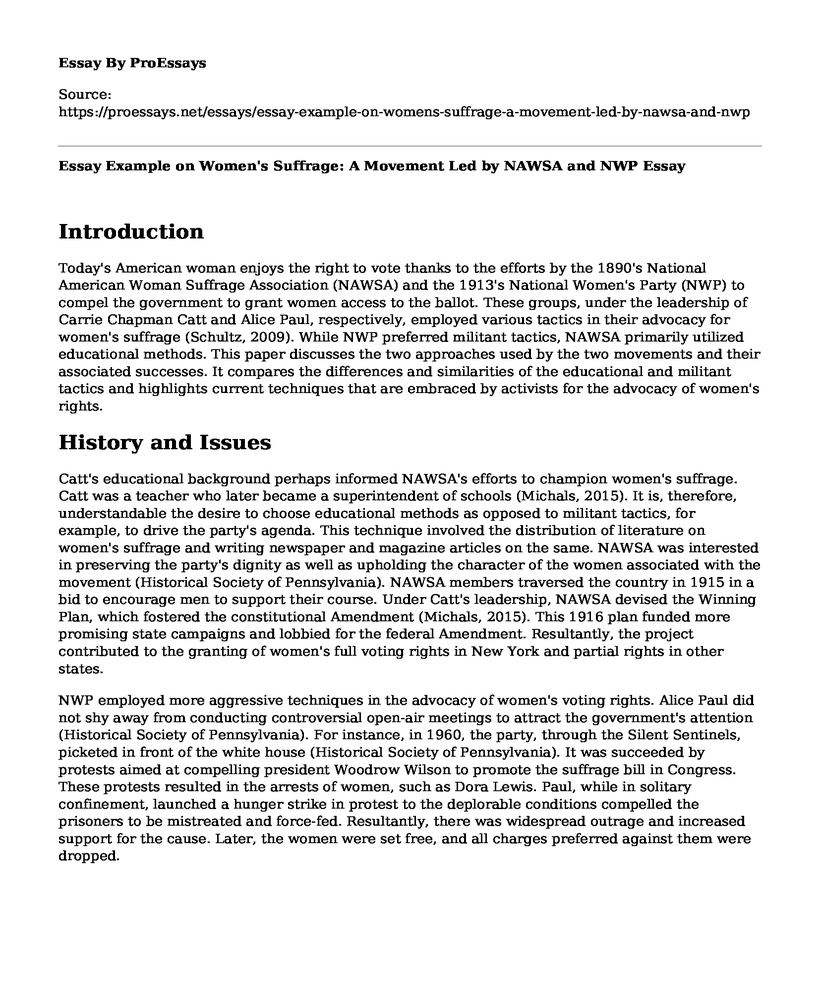Introduction
Today's American woman enjoys the right to vote thanks to the efforts by the 1890's National American Woman Suffrage Association (NAWSA) and the 1913's National Women's Party (NWP) to compel the government to grant women access to the ballot. These groups, under the leadership of Carrie Chapman Catt and Alice Paul, respectively, employed various tactics in their advocacy for women's suffrage (Schultz, 2009). While NWP preferred militant tactics, NAWSA primarily utilized educational methods. This paper discusses the two approaches used by the two movements and their associated successes. It compares the differences and similarities of the educational and militant tactics and highlights current techniques that are embraced by activists for the advocacy of women's rights.
History and Issues
Catt's educational background perhaps informed NAWSA's efforts to champion women's suffrage. Catt was a teacher who later became a superintendent of schools (Michals, 2015). It is, therefore, understandable the desire to choose educational methods as opposed to militant tactics, for example, to drive the party's agenda. This technique involved the distribution of literature on women's suffrage and writing newspaper and magazine articles on the same. NAWSA was interested in preserving the party's dignity as well as upholding the character of the women associated with the movement (Historical Society of Pennsylvania). NAWSA members traversed the country in 1915 in a bid to encourage men to support their course. Under Catt's leadership, NAWSA devised the Winning Plan, which fostered the constitutional Amendment (Michals, 2015). This 1916 plan funded more promising state campaigns and lobbied for the federal Amendment. Resultantly, the project contributed to the granting of women's full voting rights in New York and partial rights in other states.
NWP employed more aggressive techniques in the advocacy of women's voting rights. Alice Paul did not shy away from conducting controversial open-air meetings to attract the government's attention (Historical Society of Pennsylvania). For instance, in 1960, the party, through the Silent Sentinels, picketed in front of the white house (Historical Society of Pennsylvania). It was succeeded by protests aimed at compelling president Woodrow Wilson to promote the suffrage bill in Congress. These protests resulted in the arrests of women, such as Dora Lewis. Paul, while in solitary confinement, launched a hunger strike in protest to the deplorable conditions compelled the prisoners to be mistreated and force-fed. Resultantly, there was widespread outrage and increased support for the cause. Later, the women were set free, and all charges preferred against them were dropped.
Comparison
The educational methods employed by NAWSA were vital in ensuring that the women were well informed on the historical injustices meted on them. Additionally, it was possible to intellectually appeal to the Congress to champion for women's suffrage. However, this method was unappealing to the adamant Wilson. Militant techniques, on the other hand, exerted the right amounts of pressure on politicians and the public (American Memory). The relentless agitation, publicity stunts, and civil disobedience that characterized this method were necessary to ensure that the 19th Amendment was signed into law. As such, I support the NWPs view as it was the more successful of the two. The downside to this tactic was that it attracted unnecessary brutality from the government, which ensured that NWP leaders were imprisoned and tortured.
Conclusion
The ratification of the 19th Amendment in 1920 was an important milestone in women's history. However, women still had to deal with issues such as discrimination in their places of work. Women earned less than their male counterparts or were treated differently based on their gender. Again, suffragists advocated for legislation such as the Equal Pay Act of 1963 and the Civil Rights Act of 1964. These advanced women's rights. Today, organizations such as the National Organization for Women (NOW) are championing issues such as reproductive rights and justice and ending violence against women.
References
American Memory. (n.d.) Tactics and techniques of the national woman's party suffrage campaign. Retrieved from: https://www.loc.gov/static/collections/women-of-protest/images/tactics.pdf
Historical Society of Pennsylvania. (n.d.) Women's suffrage: Methods of protest. Retrieved from: https://hsp.org/education/unit-plans/pennsylvania-women-and-the-quest-for-womens-suffrage/womens-suffrage-methods-of-protest
Michals, D. (2015). Carrie Chapman Catt. National Women's History Museum. Retrieved from: https://www.womenshistory.org/education-resources/biographies/carrie-chapman-catt
Schultz, K. (2009). HIST: U.S history since 1865. Cengage Learning.
Cite this page
Essay Example on Women's Suffrage: A Movement Led by NAWSA and NWP. (2023, Mar 28). Retrieved from https://proessays.net/essays/essay-example-on-womens-suffrage-a-movement-led-by-nawsa-and-nwp
If you are the original author of this essay and no longer wish to have it published on the ProEssays website, please click below to request its removal:
- Homeless and Veterans Essay Example
- Paper Example on Healthcare Issue - Opioid Epidemic
- Stop Wearing and Buying Fur Clothes Essay Example
- Addiction: A Study of Career Counseling in Relation to Holland and Work Adjustment Theories - Essay Sample
- Harassment of Yang in AN Leads to Job Loss - Essay Sample
- From Personal Choice to Public Health - Essay Sample
- "The Distance between US" Cultural and Immigration Trauma - Free Essay







